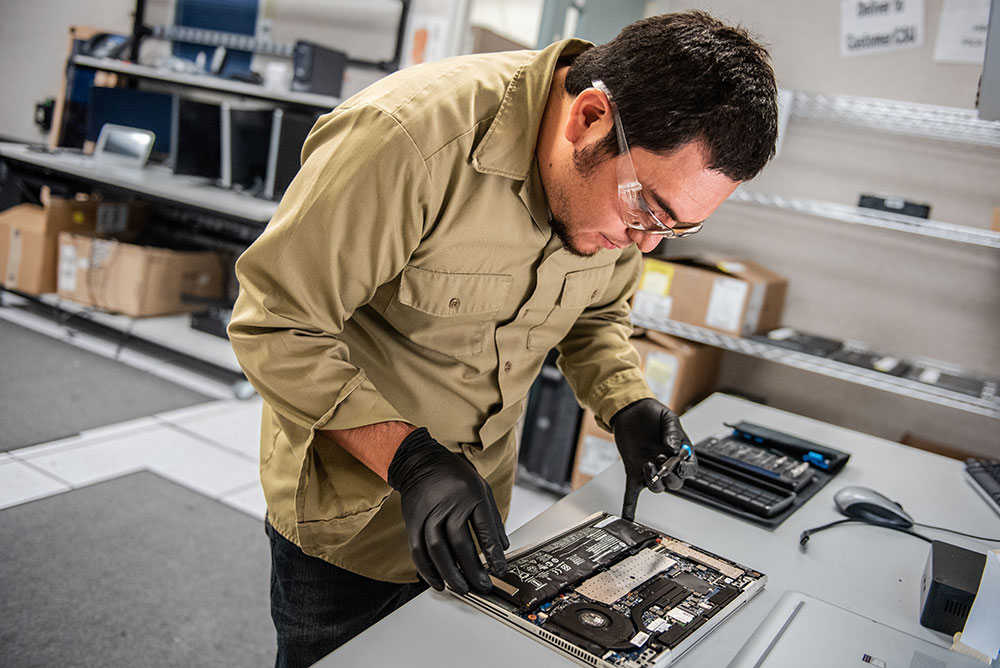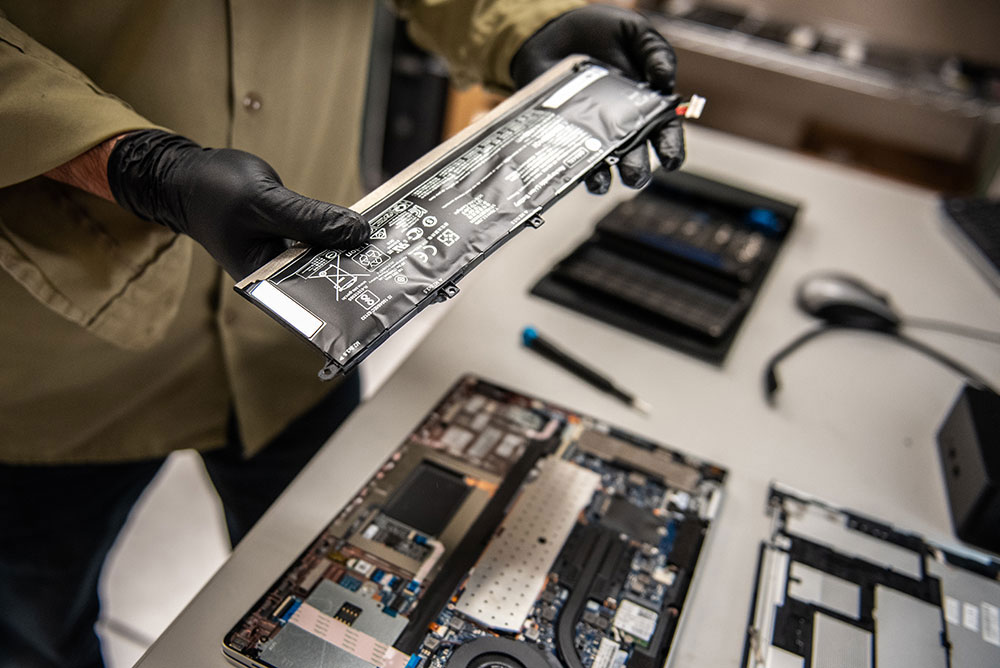First year of partnership between ES&H and IT reduced electronic waste, improved safety

You log into your Sandia laptop one morning and notice it’s not sitting flat so you pick it up, look at it, only to notice the once-sleek machine is swollen. Now what do you do?
Before December 2020, you might have called the Corporate Computing Help Desk, your department’s administrative assistant or even your division’s Environment, Safety and Health coordinator for assistance, only to find that your whole laptop had to be disposed of as hazardous waste, said Matthew Shain, an environmental technical professional.
Now, Sandia has a well-defined and centrally managed process for evaluating and handling Sandia-owned laptops, tablets and cellphones containing a damaged, deformed, bulging, swollen, ruptured or even leaking battery. Similarly, a mobile device with a bulging or separating case should not be ignored; instead, immediately stop using the device, Matthew said.
From January 2021 through January 2022, 561 electronic devices were evaluated and managed by the hardware repair depot within Information Technology Services. This team removed and disposed of the damaged batteries and then either repaired the laptop, tablet or cellphone and returned it to the customer or wiped it and sent it to Reapplication, said Chris Lucero, the service manager for the hardware repair depot.
The process saves Sandia an estimated $1,450 per laptop with a damaged battery and reduces the volume of material that is managed as hazardous waste by about 75%, he added. The team won an Environmental Excellence Award last year for implementing this process.
Hazards of damaged batteries and starting a new process
If ignored and not handled properly, a electronic device containing a damaged battery can pose a myriad of safety, security and environmental hazards, Matthew said. Damaged batteries can emit toxic gases, release hazardous chemicals, cause skin burns, catch on fire or even start a fire that damages property.
In the middle of fiscal year 2020, with Sandia’s maximized telework posture, there was even more impetus to develop and roll out a formal process for handling laptops, tablets and cellphones containing damaged batteries, Chris said.
Chris took over project management for the process in August 2020, and in December 2020, started a pilot project, in which over 50 devices with damaged batteries were evaluated. Its success led to a large-scale rollout to the rest of the Labs in January 2021.
“In the past year or so, we’ve learned that we had to improve the efficiency of picking up the devices from Sandians who have devices with defective batteries to protect their health and safety,” Chris said. “At first, people at the geographical computer support units had to go to the hardware repair depot to pick up a fireproof bag, pick up the device with a damaged battery from the customer and then deliver it to the hardware repair depot. Now, each geographical computer support unit has fireproof bags on hand. This improvement decreases the amount of time the individual has the defective device in their possession. That, in turn, decreases the time they are exposed to the risk of possible health and safety issues.”
Developing the process for handling electronic devices with damaged batteries involved IT, ES&H, industrial health, cybersecurity, hazardous waste and even logistics working together, Chris said. The contractor team that runs the hardware repair depot’s daily operations was also key in developing and implementing the process. He added, “It’s been a true exercise in collaboration across multiple departments in different divisions.”
Getting the process started also involved training the hardware repair depot team on the hazards and risks of evaluating damaged electronic devices and accumulating hazardous waste, Matthew said.
How to handle damaged electronic devices and prevent swollen batteries

Handling instructions for Sandia-owned electronic devices containing damaged batteries are posted on a tab on ES&H’s Get Rid of It website. First, the device needs to be unplugged, turned off and placed in a safe location away from combustible materials. Do not open, repair or remove the damaged battery from the device, Matthew said.
There are three main ways to get a laptop, or other electronic devices, with a damaged battery to Chris’ team. First, the customer can submit a ticket through CCHD and have someone from a computer support unit pick up the device. CCHD provides IT support over the phone and remotely, while the computer support unit provides face-to-face hardware and software IT support.
This method is recommended if the battery is leaking or otherwise poses a more immediate hazard. Second, the customer can pick up a fireproof bag from a computer support unit or the hardware repair depot, place the device with a swollen battery in the bag, and deliver it to the hardware repair depot themselves. Third, for people outside of the Albuquerque metro area, the hardware repair team will coordinate with Sandia’s logistics team to ship a properly labeled fireproof box, and the customer can safely return the device with a damaged battery through ground shipping.
Chris mentioned some tips on how to prevent a damaged battery from occurring in the first place. Specifically, periodically powering off and unplugging the laptop from the power supply decreases the likelihood of the battery swelling or otherwise being damaged. Getting into the habit of unplugging a laptop every other morning while catching up on email and plugging it in again when a low battery alert appears could reduce the risk of the battery swelling.
“Don’t leave your laptop connected to the power source 24/7 and be aware of the condition of your laptop or other mobile devices,” Chris added. “If you see the casing on your laptop start to split, don’t tape it; turn it off, unplug it and call CCHD.”